Online Gather.town Pitches
Spectroscopy & Hyperpolarization
Joint Annual Meeting ISMRM-ESMRMB & ISMRT 31st Annual Meeting • 07-12 May 2022 • London, UK

| Booth # | ||||
|---|---|---|---|---|
3560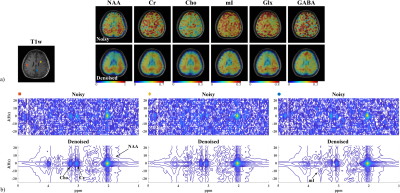 |
2 | High-SNR J-Resolved MRSI by Jointly Learning Nonlinear Representation and Projection
Yahang Li1,2, Zepeng Wang1,2, and Fan Lam1,2,3
1Department of Bioengineering, University of Illinois Urbana-Champaign, Urbana, IL, United States, 2Beckman Institute for Advanced Science and Technology, Urbana, IL, United States, 3Cancer Center at Illinois, Urbana, IL, United States J-resolved 1H-MRSI offers several unique advantages but suffers from long acquisition time and lmited SNR, especially for longer TEs. Leveraging the recent progress on constrained MRSI reconstruction using learned nonlinear low-dimensional representations, we propose here a new method for SNR-enhancing reconstruction from rapidly generated, noisy J-resolved data, that can computationally efficiently enforce an accurate nonlinear low-dimensional representation of high-dimensional J-resolved spectroscopic signals through a learned network-based project as well as complementary spatial constraints. The proposed method has been shown to improve the SNR significantly for in vivo J-resolved 1H-MRSI of the brain. |
||
3561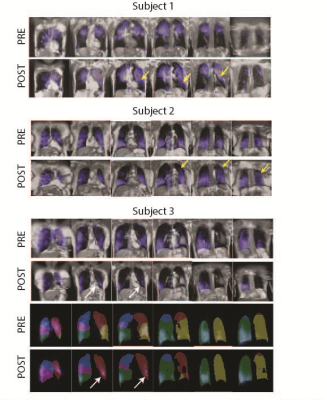 |
3 | Imaging Gas Exchange Using Hyperpolarized 129Xe as a Better Predictor of Endobronchial Valve Outcome
Hooman Hamedani1, Faraz Amzajerdian1, Stephen Kadlecek1, Ryan Baron1, Kai Ruppert1, Ian Duncan1, Mostafa Ismail1, Yi Xin1, Tahmina Achekzai1, Luis Loza1, and Rahim Rizi1
1University of Pennsylvania, Philadelphia, PA, United States
Bronchoscopic lung volume reduction (LVR) using endobronchial valves has proven effective at improving lung function and quality of life in certain severely emphysematous patients. Successful lung volume reduction of the target lobe shifts ventilation and perfusion to the healthier ipsilateral lobe and improves breathing mechanics. Functional imaging with spatially-resolved metrics using inhaled hyperpolarized 129Xe (HXe) may provide a deeper understanding of the physiology underlying clinical benefit.
|
||
3562 |
4 | Frequency Drift of "Cold" Scanner at 3T -- its Implication in MR Spectroscopy
Xiaopeng Zhou1, Ulrike Dydak1,2, and Pallab K. Bhattacharyya3
1School of Health Sciences, Purdue University, West Lafayette, IN, United States, 2Department of Radiology and Imaging Sciences, Indiana University School of Medicine, Indianapolis, IN, United States, 3Imaging institute, Cleveland Clinic, Cleveland, OH, United States Frequency drift from EPI-based sequences prior to MRS scans is a known issue. Running MRS scans ‘from cold’ is suggested for the greatest scanner stability, with some equilibration period for systems with overnight energy-saving mode. Running MRS scans before scanner reaches an equilibration period can result in large frequency drifts. Under these conditions, the effect of running fMRI scans seem to be negligible. Applying frequency and phase correction can make the final spectrum appear to be qualitatively similar between scans with big and negligible drift. |
||
3563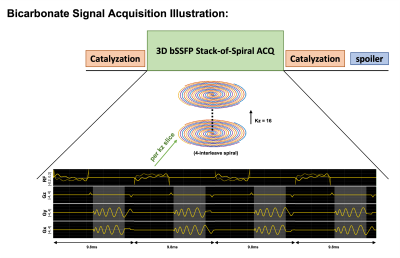 |
5 | A Metabolite Specific 3D Stack-of-Spiral bSSFP Sequence for Improved 13C-Bicarbonate Imaging in Hyperpolarized [1-13C]Pyruvate MRI
Xiaoxi Liu1, Shuyu Tang2, Robert Bok1, Hsin-Yu Chen1, Changhua Mu1, Romelyn Delos Santos1, Avantika Sinha1, Zhen J. Wang1, and Peder E.Z. Larson1
1University of California San Francisco, San Francisco, CA, United States, 2HeartVista, Los Altos, CA, United States
MRI of hyperpolarized 13C-labeled compounds is an emerging tool to non-invasively detect metabolic processes, and hyperpolarized [1-13C]pyruvate has been used in clinics for assessing cancer and cardiac metabolism. However, due to nonrenewable and progressively depleted magnetization, hyperpolarized 13C has a limitation to achieve both high spatial resolution and temporal resolution with high SNR. This study proposes a novel bicarbonate-specific 3D bSSFP sequence with stack-of-spiral readout to improve the SNR of dynamic bicarbonate imaging in hyperpolarized [1-13C]pyruvate studies. Compared to a metabolite-specific GRE sequence, the proposed MS-3DbSSFP sequence showed a 3X SNR improvement for bicarbonate imaging in rat heart and kidneys.
|
||
3564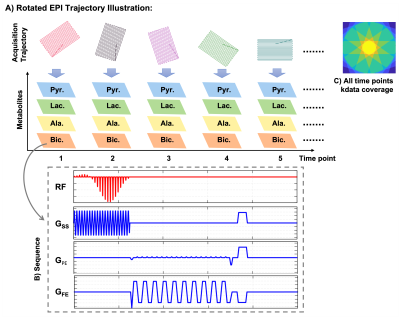 |
6 | Hyperpolarized [1-13C]Pyruvate MRI Using a Metabolite-Specific Rotated Echo-Planar Imaging Sequence with Half Scan
Xiaoxi Liu1, Di Cui1, Shuyu Tang2, Robert Bok1, Changhua Mu1, Hsin-Yu Chen1, Romelyn Delos Santos1, Avantika Sinha1, Jeremy Gordon1, and Peder E.Z. Larson1
1University of California San Francisco, San Francisco, CA, United States, 2HeartVista, Los Altos, CA, United States
Hyperpolarized 13C-labeled compound is an emerging technique in biomedical imaging to non-invasively detect metabolic processes and has been translated in clinical for cancer and cardiac metabolism studies. However, hyperpolarized MRI signal is limited by high spatial and temporal resolution and high SNR. This work describes a novel rotated Echo-planar imaging (EPI) trajectory with a half scan acquisition that shortens echo time to reduce the T2* effect in metabolic imaging. Compared to the standard full sampled EPI trajectory, the proposed trajectory has the advantage of gaining higher signal intensity, and is less sensitive to motion artifacts, distortion artifacts and aliasing artifacts.
|
||
3565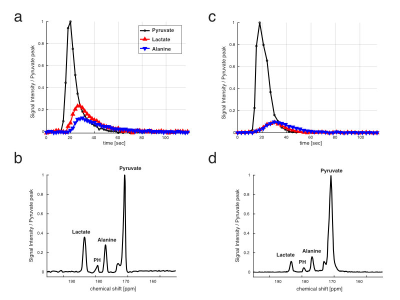 |
7 | Feasibility of Assessing Skeletal Muscle Metabolism of Muscular Dystrophy with Hyperpolarized 13C-Pyruvate
Jun Chen1, Terry Gemelli2, Pradeep Mammen2, and Jae Mo Park1,3
1AIRC, UT Southwestern Medical Center at Dallas, Dallas, TX, United States, 2Internal Medicine, UT Southwestern Medical Center at Dallas, Dallas, TX, United States, 3Radiology, UT Southwestern Medical Center at Dallas, Dallas, TX, United States
Pyruvate metabolism in skeletal muscle plays an essential role for energy production and development of muscular dystrophy (MD). However, investigation of the metabolism of MD has been focused on myocardium due to its vital importance, rather than skeletal muscle. This study presents preliminary results that demonstrate the feasibility of assessing altered pyruvate metabolism in the skeletal muscle of Becker MD patient with hyperpolarized [1-13C]pyruvate. In parallel, the metabolic profile of MD skeletal muscle was analyzed by NMR using a Duchenne MD mouse model after [U-13C3]pyruvate infusion. This study indicates that pyruvate metabolism is altered in skeletal muscle with MD.
|
||
3566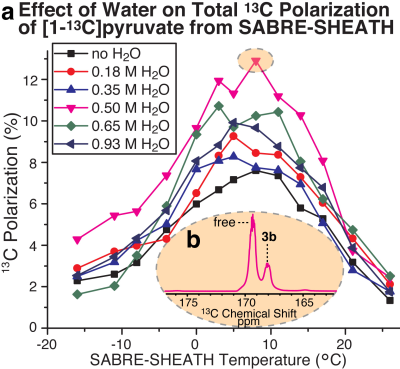 |
8 | Order-Unity 13C Nuclear Polarization of [1-13C]Pyruvate in Seconds
Eduard Y Chekmenev1, Patrick TomHon2, Mohammad S. H. Kabir3, Shiraz Nantogma3, Mustapha Abdulmojeed2, Iuliia Mandzhieva2, Jessica Ettedgui4, Rolf E. Swenson4, Murali C. Krishna5, Thomas Theis2, Boyd M. Goodson6, and Isaiah Adelabu3
1Chemistry and Oncology, Wayne State University, Detroit, MI, United States, 2Chemistry, North Carolina State University, Raleigh, NC, United States, 3Chemistry, Wayne State University, Detroit, MI, United States, 4National Heart, Lung, and Blood Institute, Bethesda, MD, United States, 5National Cancer Institute, Bethesda, MD, United States, 6Southern Illinois University Carbondale, Carbondale, IL, United States
This presentation covers the recent advances in spin physics and instrumentation of Signal Amplification By Reversible Exchange (SABRE) in SHield Enables Alignment Transfer to Heteronuclei (SHEATH). Order unity 13C polarization for [1-13C]pyruvate was demonstrated for catalyst-bound species by SABRE-SHEATH, which becomes possible due to favorable 13C relaxation dynamics in a microtesla magnetic field. The magnetic field, temperature and co-solvents heavily modulate the attainable 13C polarization, providing an opportunity for optimization to deliver highly polarized [1-13C]pyruvate quickly and cheaply for biomedical applications. The design of clinical-scale hyperpolarizer is described for production of [1-13C]pyruvate and other metabolically relevant hyperpolarized contrast agents.
|
||
3567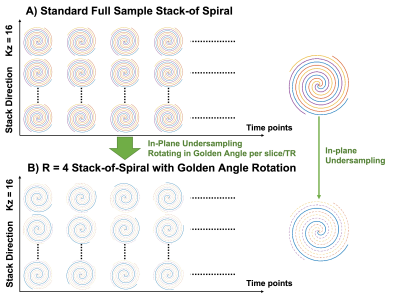 |
9 | 3D Golden Angle Stack-of-Spiral bSSFP Sequence for Undersampled Lactate Imaging in Hyperpolarized MRI
Xiaoxi Liu1, Shuyu Tang2, Di Cui1, Sule Sahin1, Nicholas Dwork1, Zhen J. Wang1, and Peder E.Z. Larson1
1University of California San Francisco, San Francisco, CA, United States, 2HeartVista, Los Altos, CA, United States
In the previous work, 3D balanced steady state free precession (bSSFP) sequence have been used to improve SNR for hyperpolarized 13C lactate imaging. In this study, we proposed a 3D bSSFP stack-of-spiral with golden angle rotation sequence for lactate imaging to furtherly accelerate lactate imaging. At the same time, we designed a regularized reconstruction method for the undersampled data that did not degrade image quality.
|
||
3568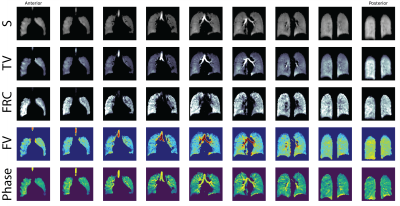 |
10 | Quantifying Ventilation Using Dynamic Xenon MRI During Free Breathing
Hooman Hamedani1, Faraz Amzajerdian1, Stephen Kadlecek1, Ryan Baron1, Kai Ruppert1, Ian Duncan1, Mostafa Ismail1, Yi Xin1, Tahmina Achekzai1, Luis Loza1, and Rahim Rizi1
1University of Pennsylvania, Philadelphia, PA, United States
In order to image function in the free breathing lung with high temporal and special resolution, we have developed a passive, mechanically controlled MR-friendly gas delivery device capable of real time dosimetry and end-tidal gas measurements that can be used in combination with a non-rigid image registration technique. These dynamic images can thus be translated into comprehensible quantitative maps of lung ventilation and gas exchange. In order to image the lung continuously during normal breathing, we have also developed a fast-acquisition pulse sequence that uses diaphragm position to facilitate image reconstruction.
|
||
3569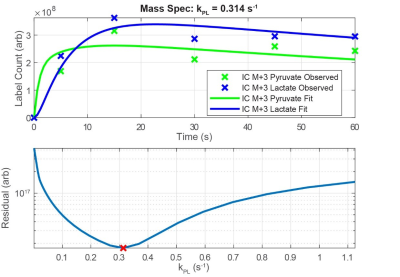 |
11 | Quantitative Evaluation of Pyruvate Uptake and Metabolism in Cells using Mass Spectrometry and Hyperpolarized 13C NMR
Collin J. Harlan1,2, Joshua S. Niedzielski3, Keith A. Michel 2, Yunyun Chen4, Gary V. Martinez2, Philip L. Lorenzi5, Lin Tan5, Matthew E. Merritt6, Mukundan Ragavan6, Vlad C. Sandulache7, Stephen Y. Lai4,8,9, and James A. Bankson2
1The University of Texas MD Anderson Cancer Center UTHealth Graduate School of Biomedical Sciences, Houston, TX, United States, 2Department of Imaging Physics, The University of Texas MD Anderson Cancer Center, Houston, TX, United States, 3Department of Radiation Physics, The University of Texas MD Anderson Cancer Center, Houston, TX, United States, 4Department of Head and Neck Surgery, The University of Texas MD Anderson Cancer Center, Houston, TX, United States, 5Department of Bioinformatics and Computational Biology and The Proteomics and Metabolomics Core Facility, The University of Texas MD Anderson Cancer Center, Houston, TX, United States, 6Department of Biochemistry and Molecular Biology, University of Florida, Gainesville, FL, United States, 7Department of Otolaryngology-Head and Neck Surgery, Baylor College of Medicine, Houston, TX, United States, 8Department of Radiation Oncology, The University of Texas MD Anderson Cancer Center, Houston, TX, United States, 9Department of Molecular and Cellular Oncology, The University of Texas MD Anderson Cancer Center, Houston, TX, United States
Metabolic imaging of hyperpolarized pyruvate can provide new insight into cancer progression and therapeutic response. Pharmacokinetic modeling can be used to determine kPL, the apparent rate constant for conversion of hyperpolarized pyruvate into lactate. Quantitative evaluation of signal evolution in vivo can be challenging due to nonstationary signal and multiple barriers between the intravascular precursor and its intracellular conversion into lactate. In this work, we evaluated intracellular kPL using suspensions of anaplastic thyroid cancer and prostate cancer cells. A pharmacokinetic model with two physical compartments and two chemical pools was utilized for quantitative analysis.
|
||
3570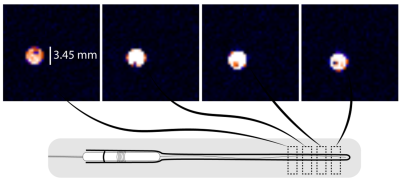 |
12 | Recent advances in parahydrogen induced polarization for hyperpolarized low-field MRI Video Not Available
Thomas Theis1, Patrick TomHon1, Soeren Lehmkuhl1, Boyd Goodson2, Yi-Fen Yen3, Matthew Rosen3, and Eduard Chekmenev4
1Chemistry, North Carolina State University, Raleigh, NC, United States, 2Chemistry, Southern Illinois University, Carbondale, IL, United States, 3Martinos Center for Biomedical Imaging, Harvard Medical School, Charlestown, MA, United States, 4Chemistry, Wayne State University, Detroit, MI, United States
We describe recent advances with Parahydrogen Induced Polarization (PHIP) to establish easy-to-use, inexpensive hyperpolarizers with potential for translation into preclinical and clinical practice. We show that more than 10% polarization of [1-13C]-Pyruvate can be established by SABRE-SHEATH. With those polarization levels, we demonstrate hyperpolarized MRI at 1.5 T of a cryogen-free MRI system. We also describe a PHIP reactor that provides continuous hyperpolarization and achieves RASER (Radio-wave Amplification by Stimulated Emission of Radiation), which gives 100% background free, high resolution MR signals. By combining PHIP methods with low-field MRI, an affordable yet highly sensitive molecular imaging approach may emerge.
|
||
3571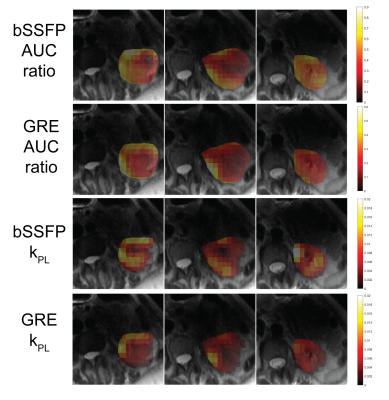 |
13 | Mapping Pyruvate-to-Lactate Rate Constants in Hyperpolarized Data with bSSFP Acquisitions
Sule Sahin1,2, Nicholas Dwork1, Shuyu Tang3, Xiaoxi Liu1, Zhen Jane Wang1, and Peder E.Z. Larson1
1Radiology, University of California, San Francisco, San Francisco, CA, United States, 2UC Berkeley - UCSF Graduate Program in Bioengineering, Berkeley, CA, United States, 3HeartVista, Los Altos, CA, United States
Using a metabolite-specific bSSFP sequence for hyperpolarized [1-13C]pyruvate MRI has been shown to increase SNR significantly, yet specialized kPL methods have not been developed for this sequence. A kPL fitting method for bSSFP lactate acquisition was developed and voxel-wise kPL fitting was performed on four renal cell carcinoma subjects. The kPL values and maps were compared to and showed agreement with lactate over pyruvate AUC ratio maps and spoiled gradient echo kPL values and maps.
|
||
3572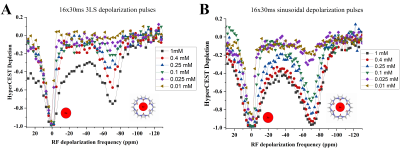 |
14 | Saturation pre-pulse train optimization for maximization of cucurbit[6]uril hyperpolarized chemical exchange saturation transfer at 3.0 T
Vira Grynko1,2, Yurii Shepelytskyi2,3, Tao Li3, Hannah Aalto4, Iulian Constantin Ruset5, and Mitchell S Albert2,3,6
1Chemistry and Materials Science Program, Lakehead University, Thunder Bay, ON, Canada, 2Thunder Bay Regional Health Research Institute, Thunder Bay, ON, Canada, 3Chemistry Department, Lakehead University, Thunder Bay, ON, Canada, 4Applied Life Science Program, Lakehead University, Thunder Bay, ON, Canada, 5Xemed LLC, Durham, NH, United States, 6Northern Ontario School of Medicine, Thunder Bay, ON, Canada
Cucurbit[6]uril (CB6) is a well-known hyperpolarized 129Xe (HP 129Xe) MRI contrast agent. Although in-vivo biodistribution detection of CB6 has already been achieved, no studies have been performed on optimization of the saturation pre-pulse train in order to maximize CB6 performance. In the present work, we demonstrate that utilization of sinusoidal saturation pulses for 129Xe HyperCEST MRI, instead of using conventional three-lobe sinc pulses, yields substantial improvement of CB6 HyperCEST performance and a significant increase in HyperCEST MRI sensitivity. In addition, lower detectable CB6 concentrations are reported for both types of saturation pre-pulses at 3T using a whole-body scanner.
|
||
3573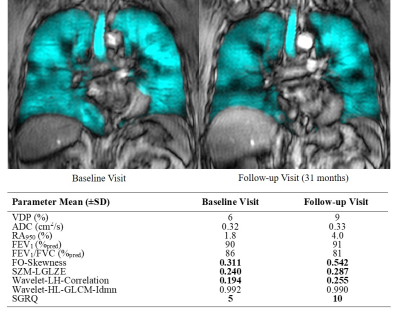 |
15 | Quality-of-life Worsening Predicted Using Baseline Hyperpolarized 3He MRI Ventilation Texture Features and Machine-Learning
Maksym Sharma1,2, Harkiran K Kooner1,2, Marrissa J McIntosh1,2, David G McCormack3, and Grace Parraga1,2,3,4
1Department of Medical Biophysics, Western University, London, ON, Canada, 2Robarts Research Institute, Western University, London, ON, Canada, 3Division of Respirology, Department of Medicine, Western University, London, ON, Canada, 4School of Biomedical Engineering, Western University, London, ON, Canada
Texture analysis may be used to extract quantitative information from hyperpolarized 3He MR ventilation images to help explain clinically-relevant outcomes and disease progression. We aimed to combine texture analysis with machine-learning to generate classification models for predicting worsening quality-of-life in ex-smokers with and without COPD. We identified six texture feature contributors, which outperformed standard imaging and clinical variables, with the top machine-learning model achieving a classification accuracy of 80.2% at predicting worsening quality-of-life within 2-3 years. These pilot results suggest that 3He MRI texture features may provide additional prognostic information to predict clinically-relevant changes in quality-of-life in ex-smokers.
|
||
3574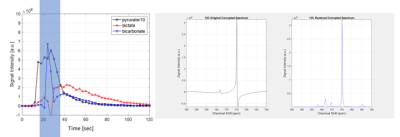 |
16 | Restoration of corrupted 13C MR spectroscopy with signal overflow
Leon Sergey Khalyavin1 and Jae Mo Park1
1University of Texas at Dallas, Richardson, TX, United States
This study aims to reconstruct 13C spectrum from FID that is corrupted by signal overflow. As the corruption often occurs in the beginning of the FID, an uncorrupted section can be reconstructed as a time-delayed version of the FID. The T2*, M0, and frequency of metabolite peaks can be calculated from the reconstructed spectrum of the uncorrupted FID signal. Since the T2* is an innate property of the compound, it can be used to extrapolate the M0 of the original signal using a mono-exponential function for each peak. The method was tested with dynamic hyperpolarized 13C MRS data.
|
||
The International Society for Magnetic Resonance in Medicine is accredited by the Accreditation Council for Continuing Medical Education to provide continuing medical education for physicians.